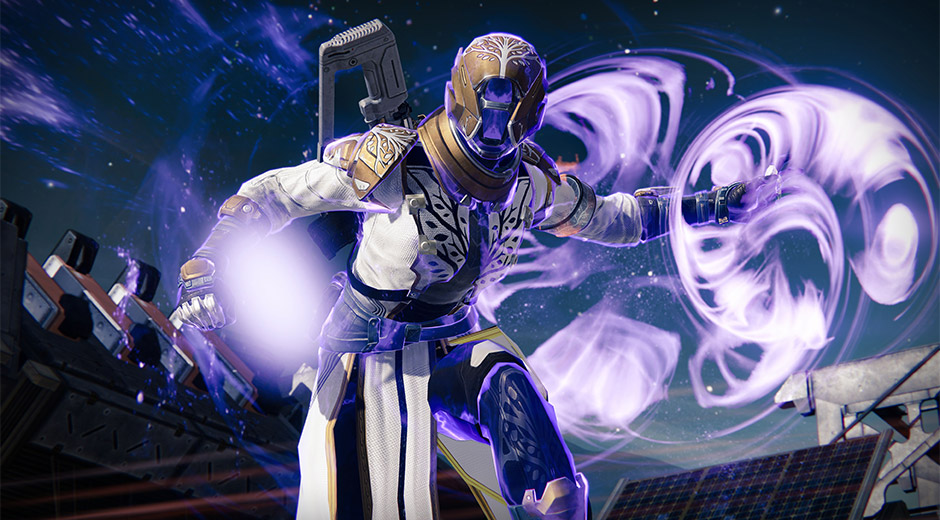
Destiny: You Got Your MMO in My FPS!
Destiny is something new. Developer Bungie has infused the fast-paced console first-person-shooter action it helped to make famous with elements traditionally reserved for role-playing games, especially the massively multiplayer online variety. It’s a neat trick.
But don’t panic, shooter fans! These MMORPG elements are nothing to be afraid of. In fact, you just might find that they make the FPS experience that much more interesting. To help ease the transition, we’ve put together a primer on Destiny‘s MMO-ish qualities, and how they impact gameplay. For example:
Character Creation
The first thing you’ll need to do when booting up Destiny is create your character. You pick a race (Human, the ethereal Awoken, or the robotic Exo) and a gender, then customize your character’s appearance as much – or as little – as you desire. But if that sort of thing isn’t your bag, don’t worry; the choices here are purely cosmetic.
Less cosmetic is the choice of class – Hunter, Titan, or Warlock – but even here, the differences are subtle. Remember, Destiny is indeed a shooter at its core, which means that every class is going to be doing a lot of shooting. You can check out our class guide from the beta to see exactly what each class does, but if you’re a shooter fan who wants to get on with it already, just choose the Titan class and move on.
Experience Points and Leveling
Shortly after you begin your enemy-slaying career, you’ll notice another RPG-like development: You’ve gone up a level! But hold up there, champ; don’t worry that you’re going to have to allocate points to your charisma trait or anything. Leveling in Destiny generally just means that you’re now more of a badass. Your core abilities are better, meaning you can take on tougher enemies. You also get access to better gear that makes you even more of a badass. And you’ll find yourself able to enter areas you couldn’t get to before – at least, not without getting slaughtered the minute you wandered in. So, it’s all good.
Now, as you reach higher levels, you get the opportunity to pick a different subclass (read: specialty), and you can then take on certain types of missions that you couldn’t before. By this time, you’ll have enough experience with the game to know whether those are the sorts of things you’d like to pursue. If not, that’s totally cool. Destiny is all about playing the way you want to play.
Custom Equipment
In that vein, you also get way more flexibility when it comes to your gear than in your standard shooter. Not only do you get to choose from a staggering array of base weapons; you can also customize and upgrade them to suit your particular playing style. You also have your choice of armor, which not only offers protection, but can also boost other abilities. Plus, as you swap out your duds, you’ll see those changes immediately reflected in your character (most of the game takes place behind the barrel of a gun, but when you visit the Tower – Destiny‘s hub – you get a third-person view of your customized character).
The process of procuring new gear and upgrading it is one of the central draws in RPGs, and it’s just as powerful here. And how do you go about procuring such things? You can find some new gear (and gear upgrades) in the game maps, which encourages exploration. Other pieces of equipment are only found at vendors in the Tower, and can be purchased with Glimmer (Destiny’s currency) collected from fallen enemies and awarded for completing missions.
Don’t feel like tweaking every little detail about your appearance? Then don’t! You can just check out whether a new bit of gear is better with the handy Compare function, equip it if so, and move on.
Quests
And as for those missions: Sure, they can be considered “quests,” and you even occasionally get them from non-player characters in the game world. But when it comes right down to it, these missions are simply tweaks on familiar shooter formulas.
Consider Strike missions, which are often described as “dungeons.” These are really just co-op missions where you team up with friends to clear out specific areas. Then we have Raids, six-player missions which appear late in the game and require serious planning and strategy. These bear resemblances to co-op campaign levels in more traditional shooters. You’ll also find Bounties and Nightfall Missions, both of which are akin to the sorts of challenges we’ve seen for years in FPS games.
Sure, some missions you’ll come across in Patrol mode might have you hunting down specific items or something – but hey, you were going to check that cave out anyway, right?
Socializing
Destiny is an always-connected multiplayer experience. To that end, you’re given a small suite of actions to help you communicate with other players. These are called “emotes” in MMORPG-land, and here they allow your character to point, wave, sit… or, uh, dance.
But look, this isn’t the Bizarro-world version of Footloose or anything; no one’s going to force you to dance. Just keep your thumb off the D-pad and you’ll be fine. You can get your own dance on (or not – it’s up to you!) right now: Destiny is currently available for both Xbox One and Xbox 360.
